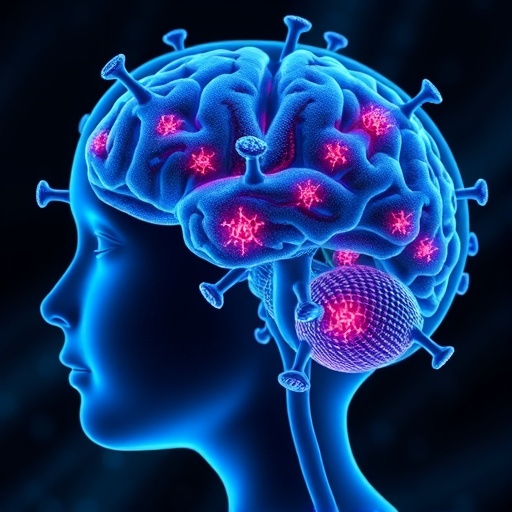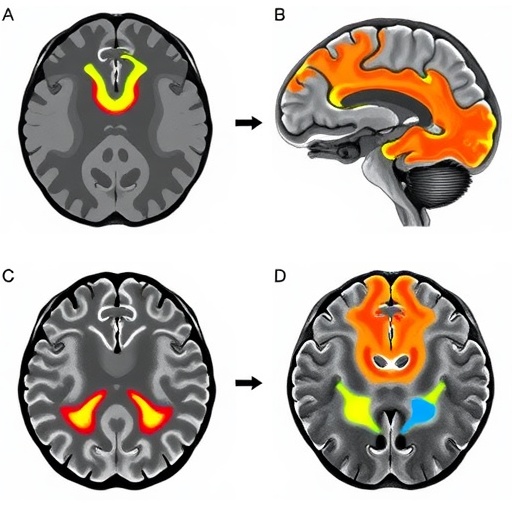
In a groundbreaking advance that could reshape the therapeutic landscape of one of the deadliest pediatric brain cancers, scientists have reported promising results from two early phase clinical trials employing an engineered oncolytic adenovirus, Ad-TD-nsIL12, targeting diffuse intrinsic pontine glioma (DIPG). This malignancy, notorious for its dismal prognosis and almost universal fatality, has remained impervious to conventional therapies, making any novel avenue of treatment a beacon of hope for patients and their families.
Diffuse intrinsic pontine glioma, particularly the IDH wild-type variant common in children, is characterized by its highly infiltrative growth within the brainstem—a region critical for basic life functions and therefore a notoriously inhospitable target for surgery and radiation. The inability to safely remove or effectively irradiate these tumors has driven researchers to develop alternative therapeutic platforms, with oncolytic virotherapy emerging as a compelling contender due to its unique mechanism of selectively infecting and destroying cancer cells while sparing healthy tissue.
The Ad-TD-nsIL12 virus represents a sophisticated fusion of genetic engineering and immunotherapeutic strategy. This oncolytic adenovirus is designed to preferentially replicate within tumor cells and concurrently express a novel form of the cytokine interleukin-12 (IL-12) fused with a nanobody, enhancing its stability and localized immune modulation. IL-12 acts as a potent immunostimulant, promoting the activation of cytotoxic T lymphocytes and natural killer cells that can target and eradicate cancer cells, while the viral infection induces direct oncolysis, effectively a double-pronged assault.
.adsslot_EZsNpbdWK7{width:728px !important;height:90px !important;}
@media(max-width:1199px){ .adsslot_EZsNpbdWK7{width:468px !important;height:60px !important;}
}
@media(max-width:767px){ .adsslot_EZsNpbdWK7{width:320px !important;height:50px !important;}
}
ADVERTISEMENT
In the two phase I clinical trials, which enrolled children diagnosed either with primary or progressive IDH wild-type DIPG, investigators sought to establish safety profiles, dosing parameters, and preliminary efficacy signals for Ad-TD-nsIL12. Despite the inherent challenges of delivering therapeutics across the blood-brain barrier and into the pons—a densely packed and critical brainstem structure—the trials successfully administered the virus via localized intratumoral or intracerebral infusions with manageable adverse effects.
The clinical data reveal that Ad-TD-nsIL12 was well tolerated among pediatric participants, with no unexpected serious adverse events related to the therapy. Importantly, biomarker analyses indicated a robust induction of immune responses within the tumor microenvironment, marked by infiltration of activated T cells and increased cytokine production in situ. These immunological changes correlated with radiographic evidence of tumor stabilization or regression in a subset of patients, suggesting that the dual mechanism of viral oncolysis and immunostimulation is operational and therapeutically relevant.
From a mechanistic perspective, the study underscores the critical role of the tumor immune microenvironment in mediating response to virotherapy. The enhanced expression of IL-12 by Ad-TD-nsIL12 appears to recalibrate the immunosuppressive milieu characteristic of DIPG into a more immunogenic landscape. This shift potentiates endogenous immune effectors capable not only of direct cytotoxicity but also of generating immunological memory, which may translate to durable tumor control and reduced relapse risk.
The engineering of the nanobody-fused IL-12 addresses a pivotal limitation of cytokine therapies—the risk of systemic toxicity due to widespread cytokine diffusion. By tethering the cytokine payload to a viral backbone that restricts expression predominantly to infected tumor cells, the approach achieves high local cytokine concentration with minimal systemic exposure. This targeted immunomodulation is a major innovation, increasing the therapeutic index and potentially enabling combination with other immunotherapeutic agents or standard treatments.
These pioneering trials also refined methods for administering the virus safely within the delicate pontine region. Utilizing advanced stereotactic neurosurgical techniques and real-time imaging guidance, researchers could navigate the complexity of the brainstem’s anatomy, enabling precise viral delivery while minimizing procedural risks. This technical achievement is a critical enabler for translating oncolytic virotherapy into routine clinical practice for DIPG.
Though the study population was limited and the trials primarily focused on safety and feasibility endpoints, the observed trends toward clinical benefit are encouraging, warranting further investigation in expanded trials with larger cohorts and extended follow-up. Future studies will aim to optimize viral dosing, explore biomarkers predictive of response, and evaluate the virus in combination with checkpoint inhibitors, radiation, or chemotherapy to amplify therapeutic effects.
The implications of this research extend beyond DIPG to other recalcitrant brain tumors and cancers where locally confined viral immunotherapies may overcome the limitations of systemic treatments. The modular design of Ad-TD-nsIL12 allows for tailoring to different tumor types or incorporation of alternative immunomodulatory payloads, heralding a new generation of precision viral therapies that can be customized for individual tumor immunobiologies.
Moreover, this work exemplifies the power of translational collaboration between virologists, immunologists, neurosurgeons, oncologists, and bioengineers. The convergence of expertise enabled the rapid bench-to-bedside advancement of a complex biologic therapeutic, emphasizing the necessity of multidisciplinary approaches to tackle formidable cancers like DIPG.
In the context of pediatric oncology, where safe and effective new treatments are desperately needed, the promise shown by Ad-TD-nsIL12 provides cautious optimism. While the road to regulatory approval and widespread clinical application will require rigorous validation in later-phase trials, this study has carved out a critical proof-of-concept for oncolytic immunovirotherapy as a viable strategy in childhood brain tumors.
This research also raises important questions regarding long-term viral persistence, immune-related adverse events, and the potential development of resistance mechanisms. Addressing these aspects will be essential to fully harness the therapeutic potential of Ad-TD-nsIL12 and similar agents.
Nevertheless, the initial clinical experience described here marks a milestone in the fight against DIPG—a notoriously intractable tumor. By harnessing the natural tropism and cytolytic capabilities of adenoviruses, augmented by targeted cytokine delivery, scientists are opening new frontiers in immuno-oncology that may ultimately translate into improved survival and quality of life for affected children and their families.
In conclusion, the trials investigating the oncolytic adenovirus Ad-TD-nsIL12 represent a significant leap forward in the development of innovative therapies for diffuse intrinsic pontine glioma. The dual-action strategy that combines direct viral-mediated tumor cell destruction with potent immune activation addresses critical challenges in treating this devastating disease, illuminating a path towards more effective and safer interventions in pediatric neuro-oncology.
Subject of Research: Oncolytic adenovirus Ad-TD-nsIL12 in pediatric IDH wild-type diffuse intrinsic pontine glioma (DIPG)
Article Title: The oncolytic adenovirus Ad-TD-nsIL12 in primary or progressive pediatric IDH wild-type diffuse intrinsic pontine glioma results of two phase I clinical trials
Article References:
Qian, X., Ning, W., Yang, J. et al. The oncolytic adenovirus Ad-TD-nsIL12 in primary or progressive pediatric IDH wild-type diffuse intrinsic pontine glioma results of two phase I clinical trials. Nat Commun 16, 6934 (2025). https://doi.org/10.1038/s41467-025-62260-5
Image Credits: AI Generated
Tags: Ad-TD-nsIL12 clinical trialschildhood cancer prognosisdiffuse intrinsic pontine glioma researchGenetic Engineering in Oncologyimmunotherapy for childhood cancerinnovative cancer treatment strategiesinterleukin-12 in cancer therapynovel treatments for DIPGoncolytic virus therapypediatric brain tumors treatmenttargeting brainstem tumorsvirotherapy in cancer management





